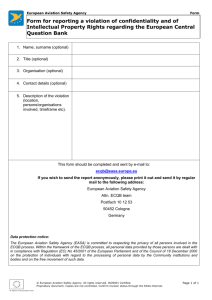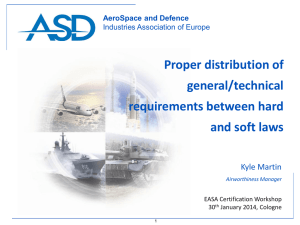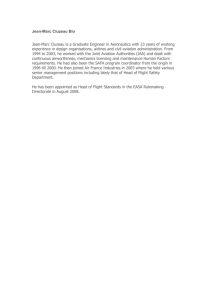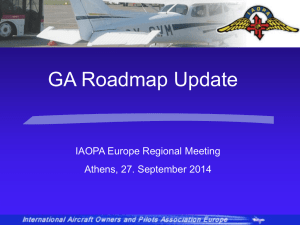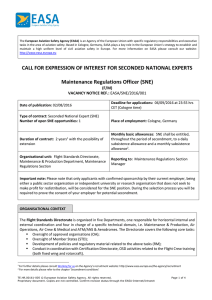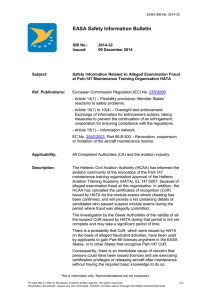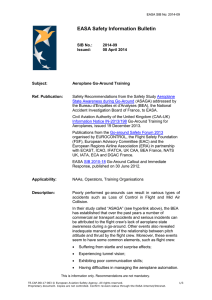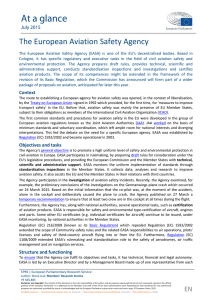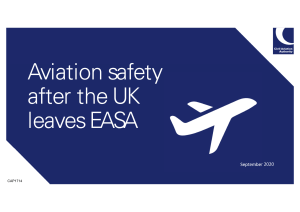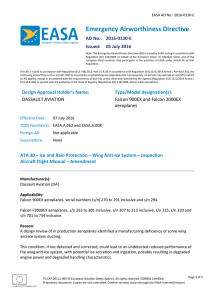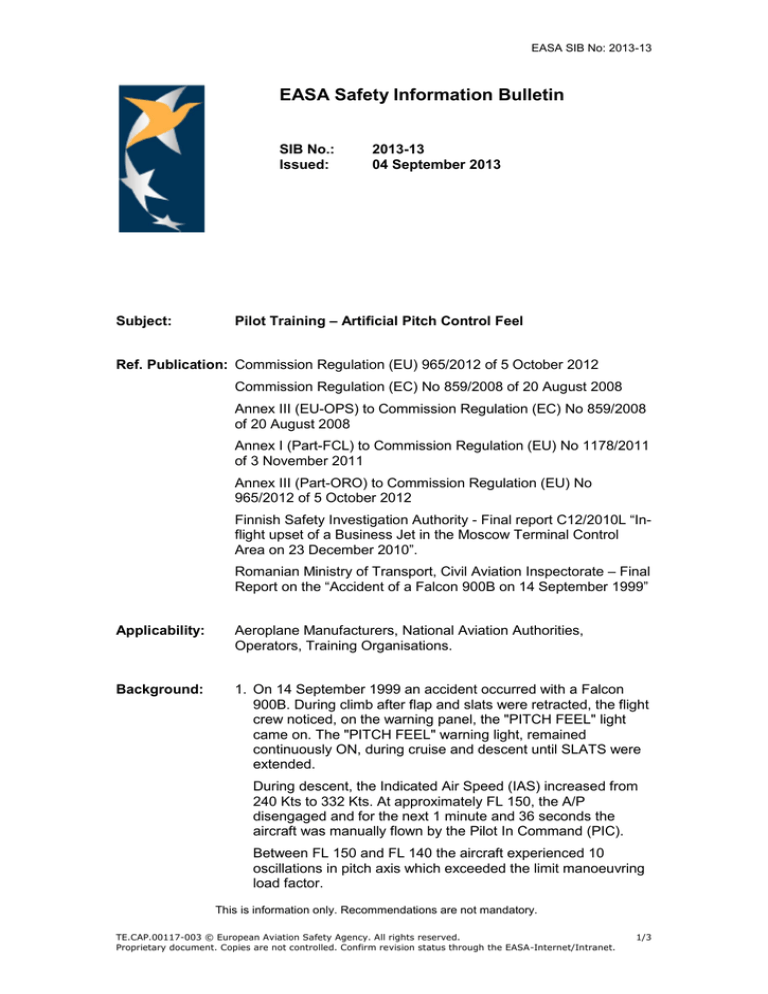
EASA SIB No: 2013-13
EASA Safety Information Bulletin
SIB No.:
Issued:
Subject:
2013-13
04 September 2013
Pilot Training – Artificial Pitch Control Feel
Ref. Publication: Commission Regulation (EU) 965/2012 of 5 October 2012
Commission Regulation (EC) No 859/2008 of 20 August 2008
Annex III (EU-OPS) to Commission Regulation (EC) No 859/2008
of 20 August 2008
Annex I (Part-FCL) to Commission Regulation (EU) No 1178/2011
of 3 November 2011
Annex III (Part-ORO) to Commission Regulation (EU) No
965/2012 of 5 October 2012
Finnish Safety Investigation Authority - Final report C12/2010L “Inflight upset of a Business Jet in the Moscow Terminal Control
Area on 23 December 2010”.
Romanian Ministry of Transport, Civil Aviation Inspectorate – Final
Report on the “Accident of a Falcon 900B on 14 September 1999”
Applicability:
Aeroplane Manufacturers, National Aviation Authorities,
Operators, Training Organisations.
Background:
1. On 14 September 1999 an accident occurred with a Falcon
900B. During climb after flap and slats were retracted, the flight
crew noticed, on the warning panel, the "PITCH FEEL" light
came on. The "PITCH FEEL" warning light, remained
continuously ON, during cruise and descent until SLATS were
extended.
During descent, the Indicated Air Speed (IAS) increased from
240 Kts to 332 Kts. At approximately FL 150, the A/P
disengaged and for the next 1 minute and 36 seconds the
aircraft was manually flown by the Pilot In Command (PIC).
Between FL 150 and FL 140 the aircraft experienced 10
oscillations in pitch axis which exceeded the limit manoeuvring
load factor.
This is information only. Recommendations are not mandatory.
TE.CAP.00117-003 © European Aviation Safety Agency. All rights reserved.
Proprietary document. Copies are not controlled. Confirm revision status through the EASA-Internet/Intranet.
1/3
EASA SIB No: 2013-13
The impact of the unfasten passengers with cabin ceiling and
aircraft furniture, due to accelerations occurring during the pitch
oscillations caused fatal injuries to 7 passengers, serious
injuries to 1 crew member and 1 passenger and minor injuries
to 2 passengers.
Following the investigation, several safety recommendations
were issued by the Romanian Civil Aviation Inspectorate,
including the following one: “Conservatively, the JAAs and the
FAA should make sure that training programs and
documentation of all operating airplanes provide sufficient
information and illustrative examples of Aircraft Pilot Coupling
and of possible unsafe crew/automation interactions.”
2. On 23 December 2010, another accident took place in the
north-western part of the Moscow Terminal Control Area
(TMA). While en-route from Moscow to St Petersburg, a
Bombardier BD-100-1A10 Challenger 300 business jet
experienced a sudden in-flight pitch upset during the climb.
There were three passengers and three crewmembers on
board. As a result of the occurrence, two passengers were
injured and some of the cabin interior was damaged. The
aircraft returned to Sheremetyevo Airport and the injured
passengers were taken to hospital in Moscow.
The Finnish Safety Investigation Authority, following analysis of
the events that led to the accident, issued three safety
recommendations, one of which addressed to EASA: “Safety
Investigation Authority, Finland recommends that the European
Aviation Safety Agency (EASA) call attention to the content of
the type training classroom instruction and simulator training of
artificial feel system operating principles, especially with regard
to aircraft types in which the system does not directly adjust in
relation to airspeed.”
Recommendations: The content of the above recommendations addresses an issue
that occurred more than once and does not appear to be related
to a single type of aeroplane. Therefore, EASA consider
appropriate to provide the following general recommendations in
the area of pilot type rating training for Operators, Approved
Training Organisations and Manufacturers:
1.
Operators and Approved Training Organisations are
encouraged to include, in their pilot training syllabi,
considerations regarding the aeroplane flight control feel
behaviour as a function of airspeed and other parameters,
especially during failure conditions.
2.
Aeroplane Manufacturers should provide relevant information
to support type rating training, where available.
3.
During the appropriate phases of the type rating training,
pilots should be made aware of the implications of pitch trim
or other relevant failures on control artificial feel. Particular
emphasis should be put on the sensitivity of the control
changes with airspeed in such systems. All training should be
This is information only. Recommendations are not mandatory.
TE.CAP.00117-003 © European Aviation Safety Agency. All rights reserved.
Proprietary document. Copies are not controlled. Confirm revision status through the EASA-Internet/Intranet.
2/3
EASA SIB No: 2013-13
consistent with the Manufacturer’s procedures and
techniques.
Contact(s):
For further information contact the Safety Information Section,
Executive Directorate, EASA. E-mail: ADs@easa.europa.eu.
This is information only. Recommendations are not mandatory.
TE.CAP.00117-003 © European Aviation Safety Agency. All rights reserved.
Proprietary document. Copies are not controlled. Confirm revision status through the EASA-Internet/Intranet.
3/3


